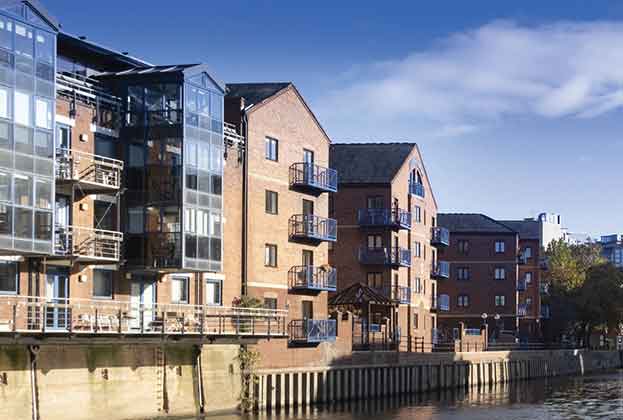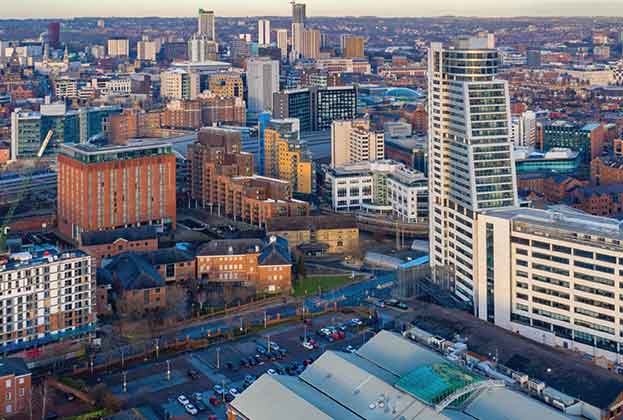Broadening the range of uses in central Leeds will draw more people to the city and support retail and leisure provision
Cities were struggling with a surplus of retail space even before Covid-19. What we are seeing in 2020/21 is an acceleration of existing trends that are changing how we view our town and city centres and the amount of retail provision needed to support them. Significant challenges face these markets: the pandemic and potential for multiple lockdowns, but also dispersed workers and shoppers and displaced tourism reducing footfall. Despite this, the retail and leisure fundamentals of Leeds, Harrogate and York remain sound, subject to rightsizing to the right offer in the right places.
Repurposing redundant retail provides an opportunity to breathe life back into town centres. Post-Covid this will be more important than ever. Mixed uses create more vibrant, more sustainable and more resilient places with greater social value. We need to recognise that hybrid space is the future of retail space.
Leeds supply and demand
Leeds is the 4th ranked retail centre in the UK, with over 3.5 million sq ft of retail and leisure space. Significant investment in recent years, such as Trinity in 2013 and Victoria Gate in 2016, has substantially enhanced the city’s retail offer. However, the consequent increase in retail stock has come at a point when consumer and occupational demand is contracting rapidly and, like every city centre in the UK, there is too much stock overall. Retail vacancy in Leeds accounts for 17% of retail units (compared to 12% nationally). Almost half of this void space, 47%, has been empty for over three years.
Recent developments attracted several new retailers into the city, but also caused migration of existing occupiers out of Commercial Street, Albion Street and Lands Lane, resulting in voids on prime retail frontage. Several landlords were forced to reduce rents on the high street. This proved good for occupational demand and subsequently allowed other retailers to move in that had previously been priced out. However, away from the main retail core the retail occupational demand has been limited.
The result is a city of two tales. The shopping centre environment and retail core has proven relatively resilient with 12% unit voids (compared to 11% nationally). The key shopping centre schemes of Trinity, St Johns, Victoria Gate and Merrion have each fared considerably better (3%, 3%, 6% and 6% respectively). Meanwhile, the secondary high street pitch has become increasingly marginalised, where vacancy averages 23% of units (compared to 13% nationally).
You’re gonna need a smaller boat
Many of the retail units in Leeds are too large. Retail units in Leeds average 3,000 sq ft across the city centre, 50% larger than the 2,000 sq ft average across UK city centres. The number of occupiers seeking large retail units has shrunk in recent years.
There is already 210,000 sq ft of redundant retail floorspace within Leeds city centre. A further 650,000 sq ft is at risk of marginalisation over the next decade, given changing retail trends. Additionally, this only accounts for ground floorspace and there is a significant amount of stock on upper floors that is underutilised by tenants who can only operate efficiently at street level. That means there is substantial city centre floorspace that would suit alternative uses.
It is these upper levels, often over 2–4 floors, that are the subject of much of the current debate around repurposing of Leeds city centre space. With so much opportunity, what should be done with it? For some, it will be a relatively simple case of converting to office use; a transition made simpler by the changes to planning use classes introduced in 2020. For larger, more complex sites, there’s potential to unlock even greater value by assembling holdings together and investing in placemaking.
The department store market across the UK has been affected more than most by changing consumer preferences in recent years. But they can also provide an excellent opportunity for repurposing projects, as their size increases the viability of redevelopment and flexibility of uses. The House of Fraser and Debenhams stores in Leeds are currently under review for repurposing or redeveloping with several alternative options on the table, including hotels, office education and student accommodation. Projects like these would help diversify and support city centre vitality and likely positively impact retail occupational demand.
While there is currently an oversupply of retail and leisure space, we are confident in the long-term resilience of each of these locations. It is true that there is too much retail floorspace and that this needs to be adapted to changing needs and considered for alternative uses. However, a right-sized retail offer will remain important to providing the needs of residents and visitors alike, while an increase in alternative uses will also serve to continue to bring people into the city centre, who, in turn, will need the service of retail and leisure provision.
View all of our latest Yorkshire Cross Sector research here.
Read the articles within Yorkshire: A region of opportunity below.
.jpg)



